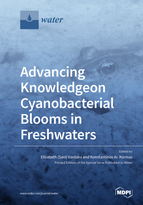Advancing Knowledge on Cyanobacterial Blooms in Freshwaters
A special issue of Water (ISSN 2073-4441). This special issue belongs to the section "Water Quality and Contamination".
Deadline for manuscript submissions: closed (31 May 2020) | Viewed by 45356
Special Issue Editors
Interests: aquatic microbial ecology; cyanobacteria; cyanotoxins; bacterioplankton; phytoplankton; human microbiome
Special Issues, Collections and Topics in MDPI journals
Interests: aquatic microbial ecology
Special Issues, Collections and Topics in MDPI journals
Special Issue Information
Dear Colleagues,
Cyanobacterial blooms are a water quality problem that has been widely acknowledged to cause detrimental ecological and economic effects in drinking and recreational waters supplies, and fisheries. There is increasing evidence that cyanobacterial blooms have increased globally and are likely to expand in water resources due to climate change. Of most concern are cyanotoxins, along with mechanisms that induce their release and fate in the aquatic envirornment. These secondary metabolites pose a potential hazard to human health and agricultural and aquaculture products directed for animal and human consumption; therefore, strict and reliable control of cyanotoxins is crucial for assessing risk. In this direction, a deeper understanding of the mechanisms that determine cyanobacterial bloom structures and toxin production become a target for managing practices.This Special Issue aims to bring together recent research of multi- and interdisciplinary approaches from the field to the laboratory and back again, driven by working hypotheses based on any aspect from ecological theory to applied research on mitigating cyanobacterial blooms. Of special interest are papers that suggest the use of complementary approaches, from the most recently developed molecular-based methods to more classical approaches and experimental and mathematical modeling regarding factors (abiotic and/or biotic) that control the diversity of not only the key bloom forming cyanobacterial species, but also their interactions to other biota, either in frehswater systems or their adjacent habitats, and their role in preventing and/or promoting cyanobacterial growth and toxin production and/or degradation.
Prof. Dr. Elisabeth (Savi) Vardaka
Prof. Dr. Konstantinos Ar. Kormas
Guest Editors
Manuscript Submission Information
Manuscripts should be submitted online at www.mdpi.com by registering and logging in to this website. Once you are registered, click here to go to the submission form. Manuscripts can be submitted until the deadline. All submissions that pass pre-check are peer-reviewed. Accepted papers will be published continuously in the journal (as soon as accepted) and will be listed together on the special issue website. Research articles, review articles as well as short communications are invited. For planned papers, a title and short abstract (about 100 words) can be sent to the Editorial Office for announcement on this website.
Submitted manuscripts should not have been published previously, nor be under consideration for publication elsewhere (except conference proceedings papers). All manuscripts are thoroughly refereed through a single-blind peer-review process. A guide for authors and other relevant information for submission of manuscripts is available on the Instructions for Authors page. Water is an international peer-reviewed open access semimonthly journal published by MDPI.
Please visit the Instructions for Authors page before submitting a manuscript. The Article Processing Charge (APC) for publication in this open access journal is 2600 CHF (Swiss Francs). Submitted papers should be well formatted and use good English. Authors may use MDPI's English editing service prior to publication or during author revisions.
Keywords
- Cyanobacteria
- Cyanotoxins
- Molecular ecology
- Human and animal health
- Risk assessment
- Nutrients
- Climate change
- Eutrophication







